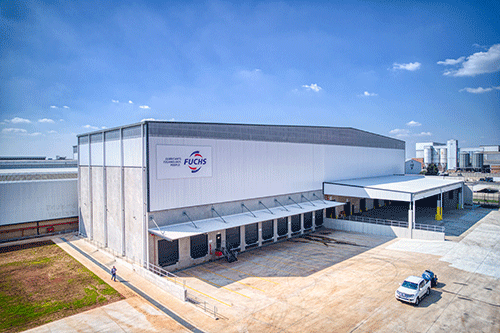

Constructed as part of its Phase 1 expansion project, the new warehouse at Fuchs Lubricants South Africa in Isando, Johannesburg, not only incorporates the latest technology but complies with stringent fire detection and prevention requirements.
“We are familiar with working in high-risk environments and were able to bring our expertise and experience to bear,” says ASP Fire CEO, Michael van Niekerk, appointed as fire engineering consultant. “It was a real team effort that went very smoothly given all the constraints posed by COVID-19 on such large-scale projects. It was a highly professional team and we all formed very good relationships with each other.”
The expansion was first mooted five years ago, with a project management team assembled in 2018 to thrash out the specifications for a planned new warehouse and blending plant. The decision by a neighbouring OEM to relocate to a new facility allowed Fuchs to acquire the adjacent site, adding impetus to the project. Board approval was received in April 2020 and construction kicked off in June 2020, with DRA Global as the main EPCM contractor.
Significant investment
“We had worked with DRA Global prior to that on our new grease plant and were fortunate to retain the same project manager for our latest expansion,” explains Fuchs Lubricants South Africa MD, Paul Deppe. It was eventually decided to split the expansion into two phases due to it being such a substantial investment.
While Phase 1 has been completed, planning is already well advanced for the next phase, with a full study already undertaken into the new blending plant. “We have done quite a bit of work on the new blending plant already, which is being used for storage at the moment,” reveals van Niekerk. The plan is to install additional fire detection and prevention equipment as an added layer of protection.
ILS was appointed as the warehouse consultant, with the building having advanced features such as wrapping of all products and 100% selectivity and batch control. The latest materials-handling equipment has been adopted, including narrow-aisle lift trucks stacking to 17 metres high. The warehouse system itself is based on a fully integrated barcoding system using SAP.
Best fire practices
In addition, the fire protection system is being designed to the latest international best practices. The warehouse features 13-metre-high cast concrete tilt-up panels that provide a firewall between the warehouse and nearby production facilities. The use of these panels in this size is believed to be a first in South Africa.
ASP Fire collaborated extensively with ILS to determine the exact height of the firewalls. “Based on radiation heat calculations we were able to advise how high the firewalls had to be to comply with the requirements,” highlights van Niekerk. Safety distance calculations were carried out between the warehouse and a small adjacent storage area.
“What is interesting about international regulations is that they reference ‘ignitable’ substances, as opposed to only combustible or flammable. This meant stringent flashpoint requirements not only for specific types of liquids, but more importantly, the type of container. The moment you store an ignitable liquid such as oil in a plastic container, it becomes a high-risk item, because obviously plastic can melt or glass break. Steel is different because it maintains the structural integrity of the container,” elaborates van Niekerk.
The firewalls had to comply with three main criteria, namely insulation, integrity and being able to deal structurally with the potential collapse of the internal racking system during a fire incident. This meant the firewalls could not collapse or deform beyond very specific requirements. A tilt-and-lift panel system was chosen to ensure compliance.

International standards
“It was a complex, high-risk building that necessitated us designing a system to cater for a range of local and international requirements,” notes van Niekerk. These included the international FM Global Property Loss Prevention Data Sheet 7-29 – Ignitable Liquid Storage in Portable Containers. It was also classified as a J1 high-risk storage and occupancy area in terms of SANS 10400: Part T – Fire Protection.
“The biggest challenge was that, being a hazardous materials warehouse, it was automatically classified as high-risk. The presence of combustible liquids made the fire protection requirements even more onerous, as there were very specific requirements for the building envelope.”
A particular achievement of the plan and rational design compiled by ASP Fire was that it managed to retain the existing pumps and tanks on-site without any need to upscale these components, resulting in a significant cost-saving and speeding up the project timeline.

© Technews Publishing (Pty) Ltd. | All Rights Reserved.